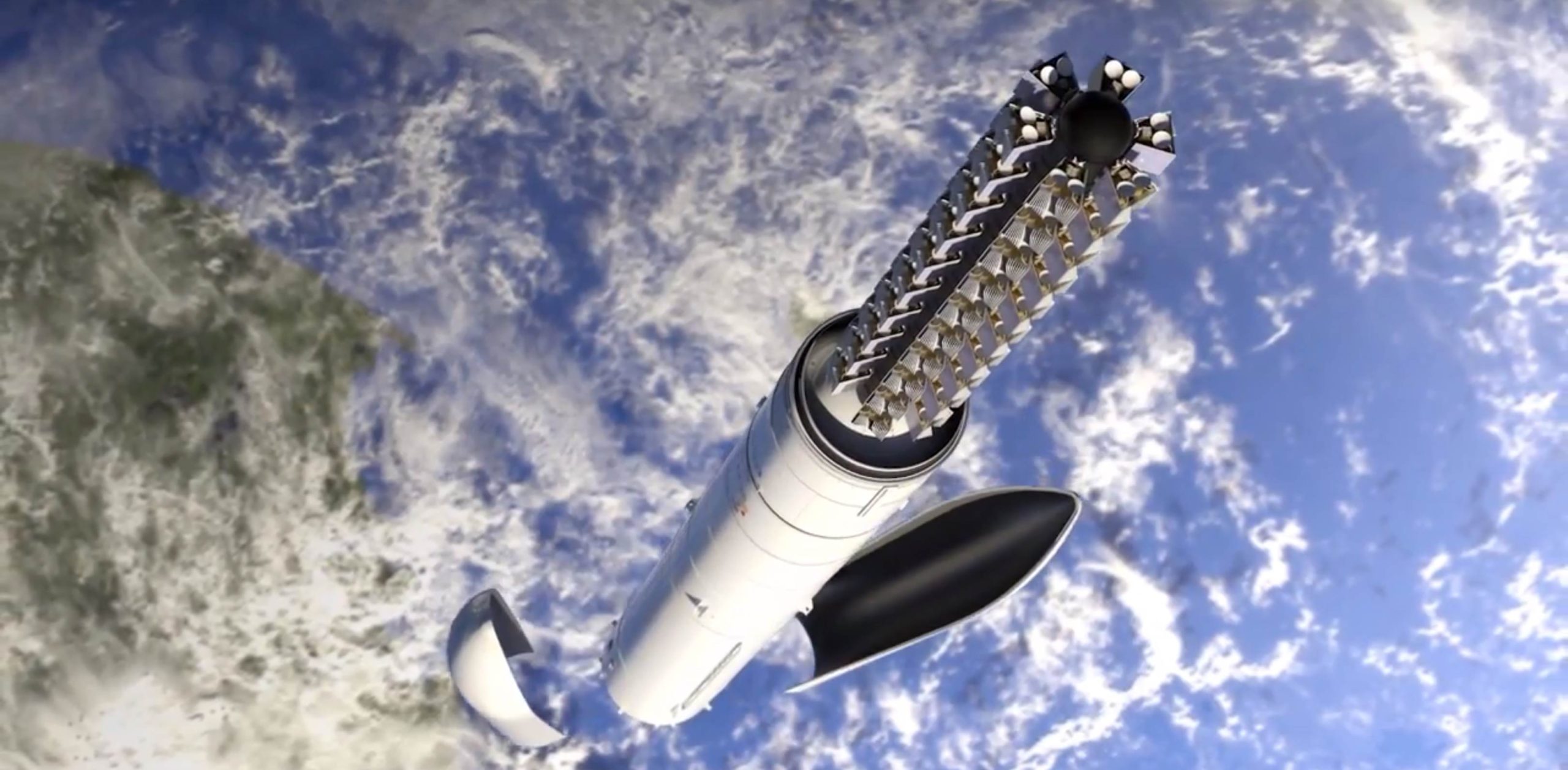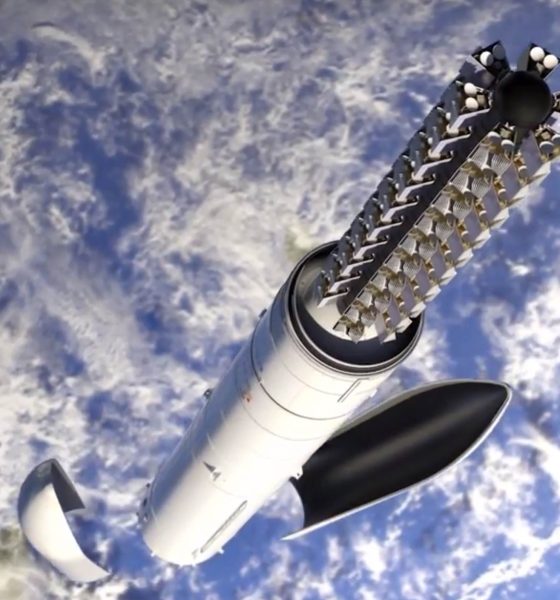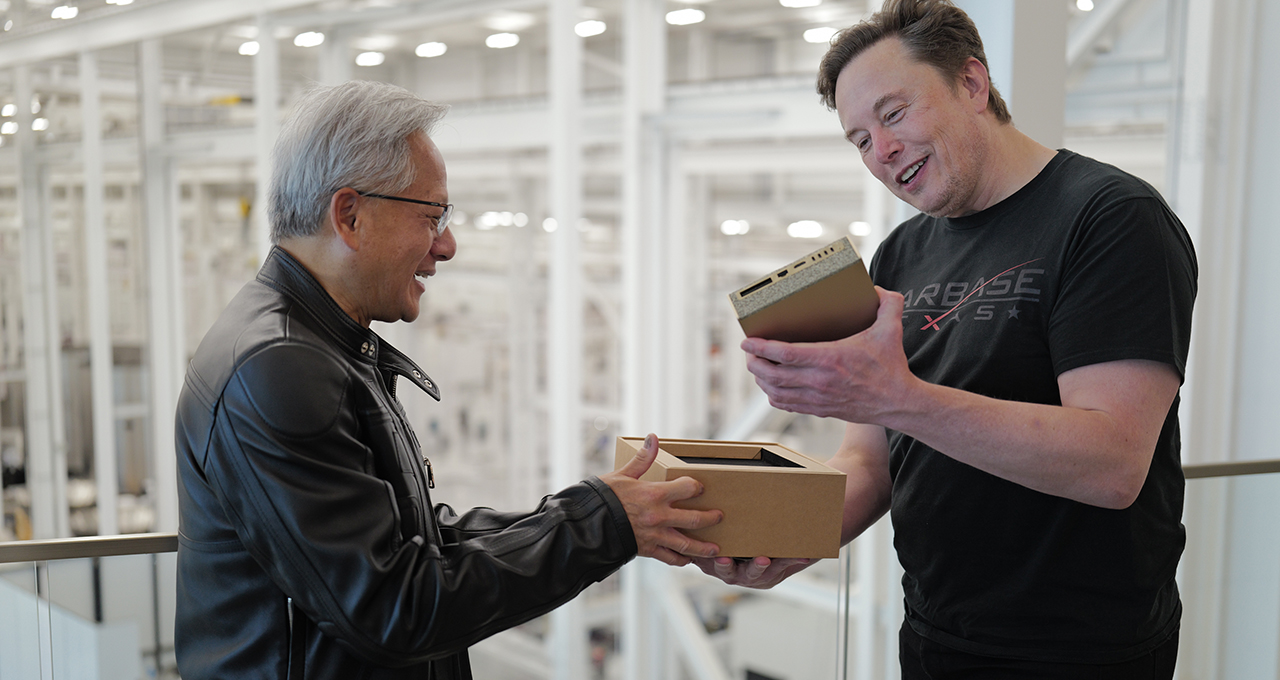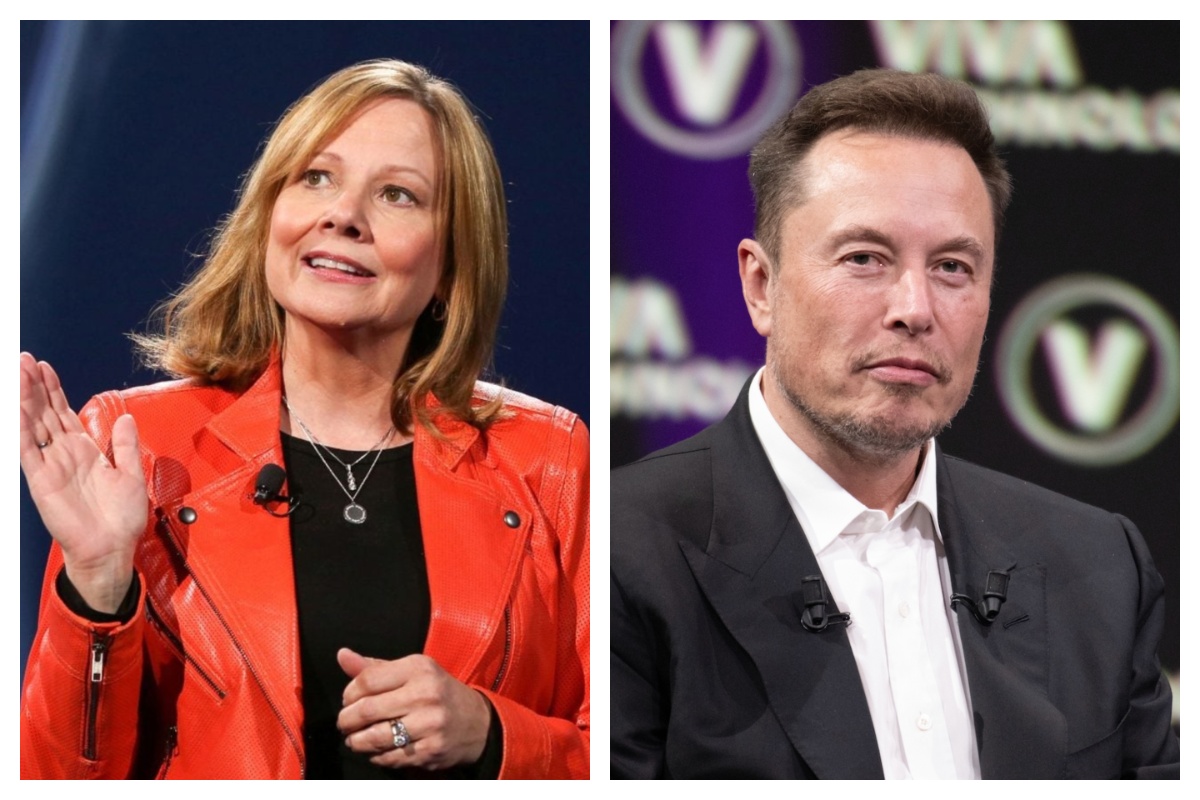

News
SpaceX’s Starlink launch debut to orbit dozens of satellites later this month
SpaceX President and COO Gwynne Shotwell has revealed that the company’s first dedicated Starlink launch is scheduled for May 15th and will involve “dozens” of satellites.
Corroborated by several sources, the actual number of Starlink satellites that will be aboard Falcon 9 is hard to believe given that it is a satellite constellation’s first quasi-operational launch. Suffice it to say, if all spacecraft reach orbit in good health, SpaceX will easily become the operator and owner of one of the top five largest commercial satellite constellations in the world with a single launch. Such an unprecedentedly ambitious first step suggests that the perceived practicality of SpaceX’s Starlink ambitions may need to be entirely reframed going forward.
From 0 to 100
In short, it’s hard to exaggerate just how much of a surprise it is to hear that SpaceX’s very first Starlink launch – aside from two prototypes launched in Feb. 2018 – will attempt to place “dozens” of satellites in orbit. Competitor OneWeb, for example, conducted its first launch in February 2019, placing just six satellites in orbit relative to planned future launches with 20-30. To go from 2(ish) to “dozens” in a single step will break all sorts of industry standards/traditions.
Despite the ~15 months that have passed since that first launch, SpaceX’s Starlink team has really only spent the last 6-9 months in a phase of serious mass-production buildup. As of now, the company has no dedicated satellite factory – space in Hawthorne, CA is far too constrained. Instead, the design, production, and assembly of Starlink satellites is being done in 3-4 separate buildings located throughout the Seattle/Redmond area.

SpaceX’s Starlink team has managed to transition almost silently from research and development to serious mass-production (i.e. dozens of satellites) in the space of about half a year. The dozens of spacecraft scheduled to launch on SpaceX’s first dedicated mission – likely weighing 200-300 kg (440-660 lb) each – have also managed to travel from Seattle to Cape Canaveral in the last few months and may now be just a few days away from fairing encapsulation.
To some extent, the first flight-ready batch of “dozens” of satellites are still partial prototypes, likely equivalent to the second round of flight testing mentioned by CEO Elon Musk last year. This group of spacecraft will have no inter-satellite laser (optical) links, a feature that would transform an orbiting Starlink constellation into a vast mesh network. According to FCC filings, the first 75 satellites will be of the partial-prototype variety, followed soon after by the first spacecraft with a more or less finalized design and a full complement of hardware.
If this is just step one…
Meanwhile, Shotwell – speaking at the Satellite 2019 conference – suggested that SpaceX could launch anywhere from two to six dedicated Starlink missions this year, depending on the performance of the first batch. Put a slightly different way, take the “dozens” of satellites she hinted at, multiply that number by 6, and you’ve arrived at the number of spacecraft she believes SpaceX is theoretically capable of producing and delivering in the next 7.5 months.
“Dozens” implies no less than two dozen or a bare minimum of 144 satellites potentially built and launched before the year is out. However, combined with a target orbit of 450 km (280 mi) and a planned drone ship booster recovery more than 620 km (385 mi) downrange, 36, 48, or 60 satellites seem far more likely. Tintin A/B – extremely rough, testbed-like prototypes – were about 400 kg (~900 lb) each.
As an example, SpaceX’s eight Iridium NEXT satellite launches had payloads of more than 10,000 kg (22,000 lb), were launched to an orbit around 630 km (390 mi), and required a upper stage coast and second burn on-orbit. Further, Iridium missions didn’t get the efficiency benefit that Starlink will by launching east along the Earth’s rotational axis. Despite all that, Falcon 9 Block 5 boosters were still able to land less than 250 km (155 mi) downrange after Iridium launches. Crew Dragon’s recent launch debut saw Falcon 9 place the >13,000 kg (28,700 lb) payload into a 200 km (125 mi) orbit with a drone ship landing less than 500 km (310 mi) downrange, much of which was margin to satisfy safety requirements.
Starlink-1’s target orbit is thus a third lower than Iridium NEXT, while its drone ship will be stationed more than 2.5 times further downrange. Combined, SpaceX’s first Starlink payload will likely weigh significantly more than ~13,000 kg and may end up being the heaviest payload the company has yet to launch.

Assuming a payload mass of ~14,000 kg (~31,000 lb) at launch, a worst-case scenario with ~400 kg spacecraft and a 2000 kg dispenser would translate to 30 Starlink satellites. Cut their mass to 300 kg and the dispenser to 1000 kg and that rises to ~45 satellites. Drop even further to 200 kg apiece and a single recoverable Falcon 9 launch could place >60 satellites in orbit.
Of course, this entirely ignores the elephant in the room: the usable volume of SpaceX’s standard Falcon payload fairing. It’s unclear how SpaceX would fit 24 – let alone 60 – high-performance satellites into said fairing without severely constraining their design and capabilities. SpaceX’s solution to this problem will effectively remain unanswered until launch, assuming the company is willing to provide some sort of press release and/or offer a live view of spacecraft deployment on their webcast. Given the cutthroat nature of competition with the likes of OneWeb, Telesat, LeoSat, and others, this is not guaranteed.

At the end of the day, such a major leap into action bodes extremely well for SpaceX’s ability to realize its ambitious Starlink constellation, and do so fast. For those on Earth without reliable internet access or any access at all, the faster Starlink – and competing constellations, for that matter – can be realized, the sooner all of humanity can enjoy the many benefits connectivity can bring. For those that sit under the thumb of monopolistic conglomerates like Comcast and Time Warner Cable, relief will be no less welcome.
Stay tuned as we get closer to Starlink-1’s May 15th launch date. Up next is a static fire of the mission’s Falcon 9 rocket, perhaps just two or three days from now.
Check out Teslarati’s Marketplace! We offer Tesla accessories, including for the Tesla Cybertruck and Tesla Model 3.

Elon Musk
NVIDIA CEO Jensen Huang commends Tesla’s Elon Musk for early belief
“And when I announced DGX-1, nobody in the world wanted it. I had no purchase orders, not one. Nobody wanted to buy it. Nobody wanted to be part of it, except for Elon.”

NVIDIA CEO Jensen Huang appeared on the Joe Rogan Experience podcast on Wednesday and commended Tesla CEO Elon Musk for his early belief in what is now the most valuable company in the world.
Huang and Musk are widely regarded as two of the greatest tech entrepreneurs of the modern era, with the two working in conjunction as NVIDIA’s chips are present in Tesla vehicles, particularly utilized for self-driving technology and data collection.
Nvidia CEO Jensen Huang regrets not investing more in Elon Musk’s xAI
Both CEOs defied all odds and created companies from virtually nothing. Musk joined Tesla in the early 2000s before the company had even established any plans to build a vehicle. Jensen created NVIDIA in the booth of a Denny’s restaurant, which has been memorialized with a plaque.
On the JRE episode, Rogan asked about Jensen’s relationship with Elon, to which the NVIDIA CEO said that Musk was there when nobody else was:
“I was lucky because I had known Elon Musk, and I helped him build the first computer for Model 3, the Model S, and when he wanted to start working on an autonomous vehicle. I helped him build the computer that went into the Model S AV system, his full self-driving system. We were basically the FSD computer version 1, and so we were already working together.
And when I announced DGX-1, nobody in the world wanted it. I had no purchase orders, not one. Nobody wanted to buy it. Nobody wanted to be part of it, except for Elon.
He goes ‘You know what, I have a company that could really use this.’ I said, Wow, my first customer. And he goes, it’s an AI company, and it’s a nonprofit and and we could really use one of these supercomputers. I boxed one up, I drove it up to San Francisco, and I delivered it to the Elon in 2016.”
The first DGX-1 AI supercomputer was delivered personally to Musk when he was with OpenAI, which provided crucial early compute power for AI research, accelerating breakthroughs in machine learning that underpin modern tools like ChatGPT.
Tesla’s Nvidia purchases could reach $4 billion this year: Musk
The long-term alliance between NVIDIA and Tesla has driven over $2 trillion in the company’s market value since 2016.
Elon Musk
GM CEO Mary Barra says she told Biden to give Tesla and Musk EV credit
“He was crediting me, and I said, ‘Actually, I think a lot of that credit goes to Elon and Tesla…You know me, Andrew. I don’t want to take credit for things.”

General Motors CEO Mary Barra said in a new interview on Wednesday that she told President Joe Biden to credit Tesla and its CEO, Elon Musk, for the widespread electric vehicle transition.
She said she told Biden this after the former President credited her and GM for leading EV efforts in the United States.
During an interview at the New York Times Dealbook Summit with Andrew Ross Sorkin, Barra said she told Biden that crediting her was essentially a mistake, and that Musk and Tesla should have been explicitly mentioned (via Business Insider):
“He was crediting me, and I said, ‘Actually, I think a lot of that credit goes to Elon and Tesla…You know me, Andrew. I don’t want to take credit for things.”
GM CEO Mary Barra said to Andrew Sorkin at the New York Times Dealbook Summit that she pulled President Biden aside and said Tesla CEO @elonmusk deserved the credit for EVs:
“He was crediting me, and I said, ‘Actually, I think a lot of that credit goes to Elon and Tesla,'” Barra… pic.twitter.com/OHBTG1QfbJ
— TESLARATI (@Teslarati) December 3, 2025
Back in 2021, President Biden visited GM’s “Factory Zero” plant in Detroit, which was the centerpiece of the company’s massive transition to EVs. The former President went on to discuss the EV industry, and claimed that GM and Barra were the true leaders who caused the change:
“In the auto industry, Detroit is leading the world in electric vehicles. You know how critical it is? Mary, I remember talking to you way back in January about the need for America to lead in electric vehicles. I can remember your dramatic announcement that by 2035, GM would be 100% electric. You changed the whole story, Mary. You did, Mary. You electrified the entire automotive industry. I’m serious. You led, and it matters.”
People were baffled by the President’s decision to highlight GM and Barra, and not Tesla and Musk, who truly started the transition to EVs. GM, Ford, and many other companies only followed in the footsteps of Tesla after it started to take market share from them.
Elon Musk and Tesla try to save legacy automakers from Déjà vu
Musk would eventually go on to talk about Biden’s words later on:
“They have so much power over the White House that they can exclude Tesla from an EV Summit. And, in case the first thing, in case that wasn’t enough, then you have President Biden with Mary Barra at a subsequent event, congratulating Mary for having led the EV revolution.”
In Q4 2021, which was shortly after Biden’s comments, Tesla delivered 300,000 EVs. GM delivered just 26.
News
Tesla Full Self-Driving shows confident navigation in heavy snow
So far, from what we’ve seen, snow has not been a huge issue for the most recent Full Self-Driving release. It seems to be acting confidently and handling even snow-covered roads with relative ease.

Tesla Full Self-Driving is getting its first taste of Winter weather for late 2025, as snow is starting to fall all across the United States.
The suite has been vastly improved after Tesla released v14 to many owners with capable hardware, and driving performance, along with overall behavior, has really been something to admire. This is by far the best version of FSD Tesla has ever released, and although there are a handful of regressions with each subsequent release, they are usually cleared up within a week or two.
Tesla is releasing a modified version of FSD v14 for Hardware 3 owners: here’s when
However, adverse weather conditions are something that Tesla will have to confront, as heavy rain, snow, and other interesting situations are bound to occur. In order for the vehicles to be fully autonomous, they will have to go through these scenarios safely and accurately.
One big issue I’ve had, especially in heavy rain, is that the camera vision might be obstructed, which will display messages that certain features’ performance might be degraded.
So far, from what we’ve seen, snow has not been a huge issue for the most recent Full Self-Driving release. It seems to be acting confidently and handling even snow-covered roads with relative ease:
FSD 14.1.4 snow storm Ontario Canada pic.twitter.com/jwK1dLYT0w
— Everything AI (@mrteslaspace) November 17, 2025
I found the steepest, unplowed hill in my area and tested the following:
• FSD 14.2.1 on summer tires
• FSD 14.2.1 on winter tires
• Manual drivingBut I think the most impressive part was how FSD went DOWN the hill. FSD in the snow is sublime $TSLA pic.twitter.com/YMcN7Br3PU
— Dillon Loomis (@DillonLoomis) December 2, 2025
Well.. I couldn’t let the boys have all the fun!
Threw the GoPro up and decided to FSD v14.2.1 in the snow. Roads were not compacted like the other day, a little slippery, but overall doable at lower speeds. Enjoy the video and holiday music 🎶
Liked:
Took turns super slow… pic.twitter.com/rIAIeh3Zu3— 🦋Diana🦋 (@99_Colorado) December 3, 2025
Moving into the winter months, it will be very interesting to see how FSD handles even more concerning conditions, especially with black ice, freezing rain and snow mix, and other things that happen during colder conditions.
We are excited to test it ourselves, but I am waiting for heavy snowfall to make it to Pennsylvania so I can truly push it to the limit.








